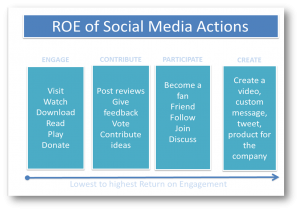You can easily distinguish the good from the bad these days. The good and bad brands I mean. The good will focus on conversation and message distribution, 24/7 interaction, an always-on strategy; the bad…well…don’t. Now, that’s very simplistic, but that way of thinking holds a lot of truth. Companies and brands become publishers of content, and while doing so they build communities of interest around their brands. Communities interested not only in consuming that content, but in engaging with it, liking-sharing-promoting-etc. Hooray -mission accomplished. Engagement leads to brand interest and love and ultimately, sales.
With that in mind, the focus should shift to Return on Engagement [ROE], instead of “simply” ROI. The goal, in the end, is a long term one. And that goal is: bigger communities, stronger loyalty, an unbreakable bond with the brand, and a desire of the consumer/user/fan to refer the brand to others.
ROI as we all know, says something about how you invest your money, and what you get back mostly in economical terms (in media terms, e.g. how much free media got generated). ROE on the other hand aims at what you get back in brand strength: to what extend did your content captivate your consumer, and has it resulted in brand equity, in making the brand stronger? Key ‘return’ components being…
- … was there ‘participation’ (Comments, Shares, Likes)
- … did it confirm ‘Authority’
- … did it generate ‘Influence’
- … did it generate ‘positive sentiment’
Easier said than done, but the “formula” is not cracked yet. The whole industry, advertisers and media alike, are in search for this holy grail answer (i.e. to what extend does a piece of content on social media contribute to brand equity of a brand).
Few thoughts on where to get started
- Define what you want to get out of ROE
- Set up continuous tracking online, on different platforms aiming at the content>equity relation
- Work in continuous, repetative intervals (since you can’t survey 24/7, nor every single piece of content), e.g. every 25 hours <I’m taking an odd number so you’d rotate time>
- a sample of your engaged user group can be surveyed to capture equity and even consumption intent
- then it can be cross-validated with another survey with a controlgroup of ‘non-consumers of the content’
- If you do that repeatedly over a period of time, patterns will occur
- Put a few other research elements in the blender, shake it all up and my guess is it will spit out interesting facts

SOURCE : http://www.slideshare.net/brandonmurphy/the-true-value-of-social-media-4267498
Caveats
1-Brand equity and brand love are obviously not built solely on social media. So the above ROE measurment is going to give you only a slice of the pie. What can i say, life is difficult 😉
2-ROE is a long term measure. Difficult for brands and companies that want to see short-term action/reaction to investments in social. Time for a mindset shift!
What do you do with ROE results/numbers?
- Build a stronger content strategy, focused on real impact
- Tailor content better to be relevant to your consumers/users
- Compare to competition so you differentiate better
- Build greater, better, stronger, more loyal brand communities -that’s the ultimate goal
Once you crack ROE, you have a strong component of ROI !
Any other views on the subject? I’d love to hear them!









{ 1 comment… read it below or add one }
Hi,
A new terminology “ROE”. In my opinion, it is and will be a guiding principal for the marketers. The way ROE and ROI have been linked and explained in the above article, adds flesh to the matter. I totally agree. Without a healthy ROE, ROI will be of less use…
Haider